Need a break from greens? you can add some pink to your houseplant collection for an elevation of elegance.
Pink is a color that never leaves the trend, maybe they are getting their limelight in different shades, but the color itself never loses its charm. people who adore pink and houseplants are fortunate, cause there are a number of pink houseplants available to fulfill your desire.
We made a list of captivating pink houseplants to enhance your indoor space. At the same time, we will also point out which plant will thrive in which situation, so it will be easy for you to determine which one to pick.
Table of Contents
Overview of Pink Houseplants
What causes plants or flowers to turn pink?
The pink we see in the plant is the outcome of reflection from that plant’s surface. Pigments known as anthocyanins are responsible for various plant colors, they use those colors to attract their pollinators.
Pink houseplants and pink flowers
Pink houseplants can create pink flowers, but not all of them are pink flowering plants. Some have pink flowers and different colored leaves, some have pink foliage and different colored flower, and some possess both.
Usually, houseplants have been intentionally bred to have a combination and contrasting of pink foliage in a variety of patterns. Because houseplants are shielded from the components, pests, and infections, they can afford to have more pink foliage than outside plants.
Shades of pink
Pink foliages and flowers in pink houseplants come in a various range of colors. To perform photosynthesis most of them have green and pink combination foliage. Usually, pink in plants comes in three shades:
- Light pink: caladium, pink polka dot, and Tradescantia Nanouk.
- Pink: Aglaonema, Pink Princess Philodendron.
- Dark pink: Calathea, bloodleaf plant.
Low-Light Environments friendly pink houseplants
1. Fittonia
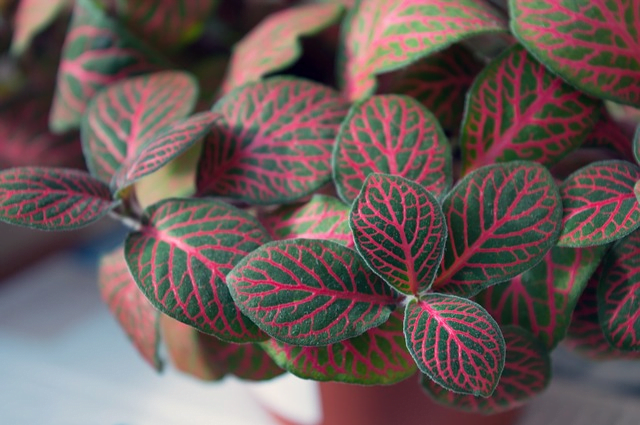
| Maintenance | Easy, suitable for beginners. |
| Water | the plant when the top surface of the soil starts to dry out. |
| Humidity | They require high humidity. Mist them with water weekly. |
| Light | Low to medium, or filtered light. |
| Fertilizer | All-purpose houseplant fertilizer, once in every month, during their growing season. Don’t feed them during winter. |
| Toxicity | Non-toxic. |
| Mature growth | 3-6 inches tall and 12-18 inches wide. |
Fittona, also known as the pink angel, is an excellent choice for new houseplants owners as they are equipped for low-light conditions. This gorgeous little plant easily will enhance your space with its unique appearance and splash of colors. A combination of dark green leaves and vibrant pink veins make it stand out among other plants.
Even though Fittona and pink angel are two popular names for this plant, my favorite one is painted net leaf, cause it just needs one look to distinguish which plant it is. Nonetheless, despite its attractive appearance, this pink houseplant is somewhat low-maintenance. The leaves have a trailing habit, so they tend to spill out from the pot edge. It can be used as a hanging basket as well as a tabletop plant. As the leaves mature, the veins deepen in color, while new leaves display more of a lighter whitish-pink color. Although the plant occasionally produces flowers if they are provided with their ideal conditions. The main charm is in its foliage rather than the flowers. The spiky red and white flowers easily get camouflaged with the leaves.
2. Christmas cactus
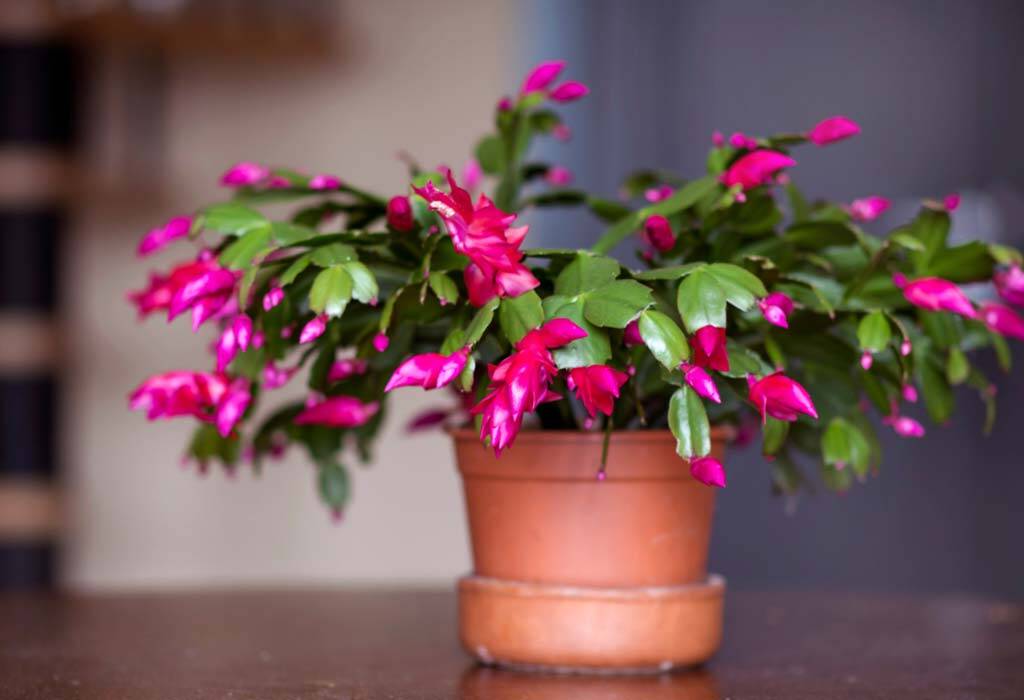
The Christmas cactus is a pink flowering houseplant.
During the winter season, the Christmas cactus stands out as a beloved plant among houseplants owners. Despite its bizarre connection with the holidays, this plant, also known as the holiday cactus, as they showcase a vibrant display of pink blossoms, bringing joy during the winter months.
Its unique structure consists of pulpy stems, which resemble flattened leaves with slight serration on each side. As late fall or early winter arrives, pink flowers burst into the tips of every stem, creating a fresh color combination of green and pink. Unlike ordinary cacti, the Christmas cactus does not originate from parched, scorching desert parts. Rather, it is a succulent that hails from tropical rainforests, where it lives on tree branches, aided by plentiful humidity, filtered sunlight, and warm weather. With proper care, your Christmas cactus can experience yearly growth and bloom at the beginning of each winter.
| Maintenance | Medium. |
| Water | They need to be thoroughly watered. Let the drain all excess water through the drainage hole. Water when the soil is almost dry. In summer two to three times and in winter once a week. |
| Humidity | Regular misting or placing a pebble tray with water under the pot. |
| Light | partial shade or filtered light. |
| Fertilizer | Monthly, half-strength, diluted fertilizer during early spring and summer. |
| Toxicity | Pet and human-friendly. |
| Mature growth | Twelve inches tall and twenty-four inches wide. |
Sun-loving Pink Houseplants
3. Cordyline

With its gorgeous pink display of sword-like leaves, this plant creates a lovely fountain-like format in its young phase, then matures into a tall, palm-like structure. ‘Pink Passion’ has been bred to maintain a more manageable size (6 feet), although it has the potential to grow over 20 feet tall.
They can be cultivated as pink houseplants or used as eye-catching focal points in summer bedding displays. Cordyline varieties can flourish both outdoors and indoors, with outdoor types having a higher chance of flowering, although rare blossoms can also be possible in houseplant cordylines. Native to southeast Asia, eastern Australia, Hawaii, and other Pacific islands, cordyline belongs to the dracaena family and grows in tropical climates with average temperatures above 55°F, while cordyline houseplants require a bright and sunny location to thrive.
| Maintenance | Easy and beginner friendly. |
| Water | Water it till the soil is evenly moist and make sure excess water is draining out of the hole. Water them once a week. |
| Humidity | Medium to high humidity. |
| Light | Six hours of bright or indirect sunlight. |
| Fertilizer | Liquid, half-strength, well-balanced fertilizer during growing seasons. |
| Toxicity | Highly toxic to pets, not recommended for pet owners. |
| Mature growth | Three to six feet indoors. |
4. Kalanchoe “pink butterflies”
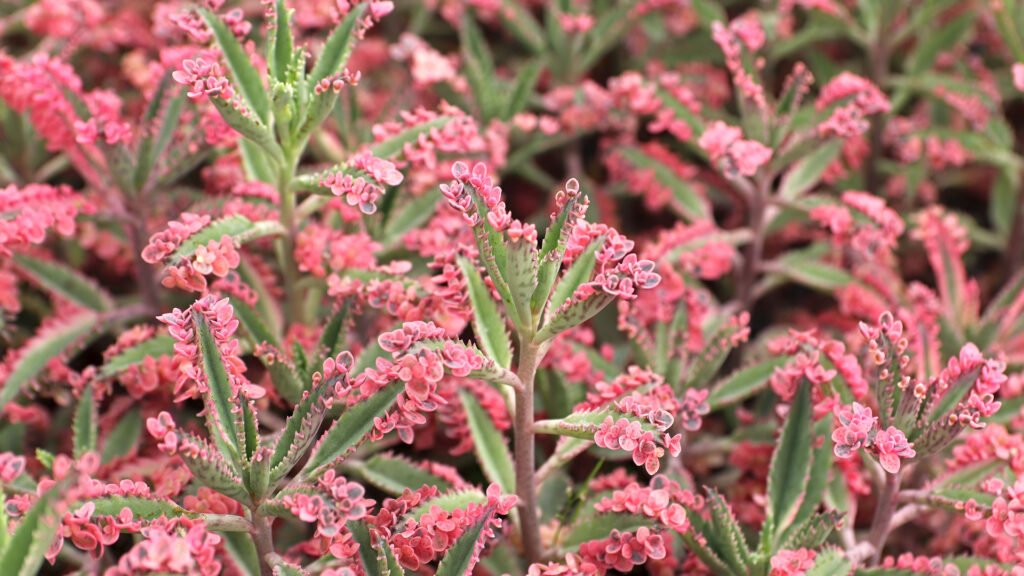
In any succulent collection, Kalanchoe ‘Pink Butterflies’ is an exceptional pink houseplant that adds a touch of elegance. What makes it truly special is its variegated nature caused by its reducing chlorophyll levels. This absence of green chlorophyll allows deep pink pigments to shine through, creating a fascinating sight.
Kalanchoe ‘Pink Butterflies,’ also known as K. x houghtonii, is a variegated hybrid caused by the crossbreeding of two species, K. delagoensis, and K. daigremontiana. This unique plant has tall stems and long, skinny leaves. Commonly referred to as “Mother of Thousands,” because it produces numerous plantlets or “bulbils” along the edges of its leaves. These bulbils have variegation, resembling a row of butterflies due to their tiny leaves and pink pigments.
| Maintenance | Tricky |
| Water | Deep and infrequent water. Water only when the soil feels completely dry. |
| Humidity | Low to medium humidity. |
| Light | They are sun-loving plants, keep them beside your sunny window sill. |
| Fertilizer | Liquid or slow-release fertilizer during the growing season for growth boost, but they don’t require fertilizers. |
| Toxicity | Not pet and human-friendly. |
| Mature growth | 10-12 inches. |
Compact Pink Houseplants
5. Tradescantia Nanouk

If you are seeking tiny pink houseplants to accentuate the beauty of your space, you can go for this easygoing Tradescantia “Nanouk.” With its striking purplish-pink-streaked leaves and unique growth pattern, Tradescantia “Nanouk” has gained popularity rather quickly even though it originated recently(2017). While Tradescantia plants have their origins in South America, this particular species was developed in the Netherlands.
Also known as Fantasy Venice, Tradescantia Nanouk has captured attention for its lush leaves, with beautiful pink, white, purple, and green stripes, showcased on upright stems. In favorable conditions, this spiderwort plant can grow as a long, trailing ivy. During the growing season, delicate white and yellow flowers also can appear from their pink buds. Notably, Tradescantia Nanouk is a quick and rapidly growing plant. They closely resemble Tradescantia fluminensis to the extent that several suppliers sell T. fluminensis by mislabeling them as Nanouk.
| Maintenance | Easy and beginner friendly. |
| Water | the plant once a week during growing seasons and once in every few weeks during other times of the year. |
| Humidity | They require high humidity, so a pebble tray or regular misting is needed if your indoors are dry. |
| Light | six to eight hours of bright indirect sunlight for flower production. |
| Fertilizer | General, all-purpose fertilizer once a month. |
| Toxicity | Toxic to humans and pets. |
| Mature growth | Not more than six inches. |
6. Polka dot plant

Certain plants possess qualities that tend to attract attention to themselves as soon as someone enters the house and the polka dot plant is definitely one of them. True to its name, this pink houseplant showcases foliage spread with delightful polka dots. Pink and green combination polka dot plants will be a great addition to your indoor garden.
Polka dot plants with pink leaf bases and green spots are the most popular, although there are also varieties available with similar spots in purple, red, white, and other colors, creating an even more eye-catching display. While they are not particularly demanding to grow inside your house, these plants are native to warm weather, that’s why many gardeners prefer to treat them as annual plants and replace them each year. It is ideal to plant them in the spring. They are perfect as container plants indoors. They grow relatively slowly indoors, making them ideal for compact areas like office spaces and small apartments.
| Maintenance | Easy |
| Water | They love moderate amounts of water. Don’t let the soil get completely dry. Water it when the top inch gets dry. |
| Humidity | Prefer high humidity, at least 50%. |
| Light | Bright, indirect light from an east or south-facing window is ideal. |
| Fertilizers | Organic houseplant fertilizers during warm seasons. |
| Toxicity | Nontoxic |
| Mature growth | 3o inches indoors. |
Pink Houseplants with Dramatic Impacts
7. Pink calla lily plant
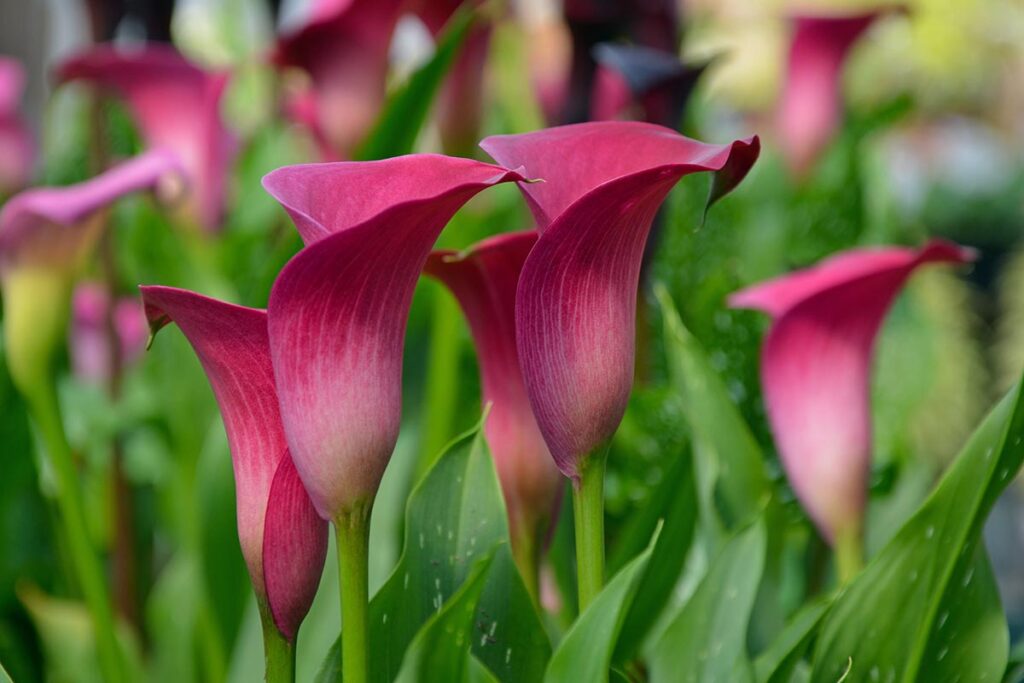
Famous for their elegant and dramatic, funnel-shaped blossoms, Calla lilies are often preferred by florists for bouquets. With a romantic appeal arising from their association with goddesses Hera and Venus, these pink flowering houseplants ooze with an extravagant charm.
Calla lilies have symbolic significance, representing rebirth and resurrection, particularly associated with the Easter holiday. Apart from pink flowers, modern hybrids offer a diverse range of colors. These flowers are known for their grace containers, borders, mass plantings, and cut flower arrangements with their long-lasting beauty for weeks. As tropical plants, these plants also can be cultivated from rhizomes. Although they are not related to lilies, calla lilies possess similar qualities and are chosen by gardeners with their ease of cultivation and care.
| Maintenance | easy to medium. |
| Water | When planting, keep the potting mix lightly moist. When the plant starts to grow and produce flowers, you can gradually increase the amount of water. |
| Humidity | Average room level humidity(40 percent) to high humidity. |
| Light | Bright and indirect sunlight. |
| Fertilizer | High-phosphorus liquid fertilizers during spring. |
| Toxicity | is Slightly toxic. |
| Mature Growth | Two feet tall. |
8. Pink Princess Philodendron
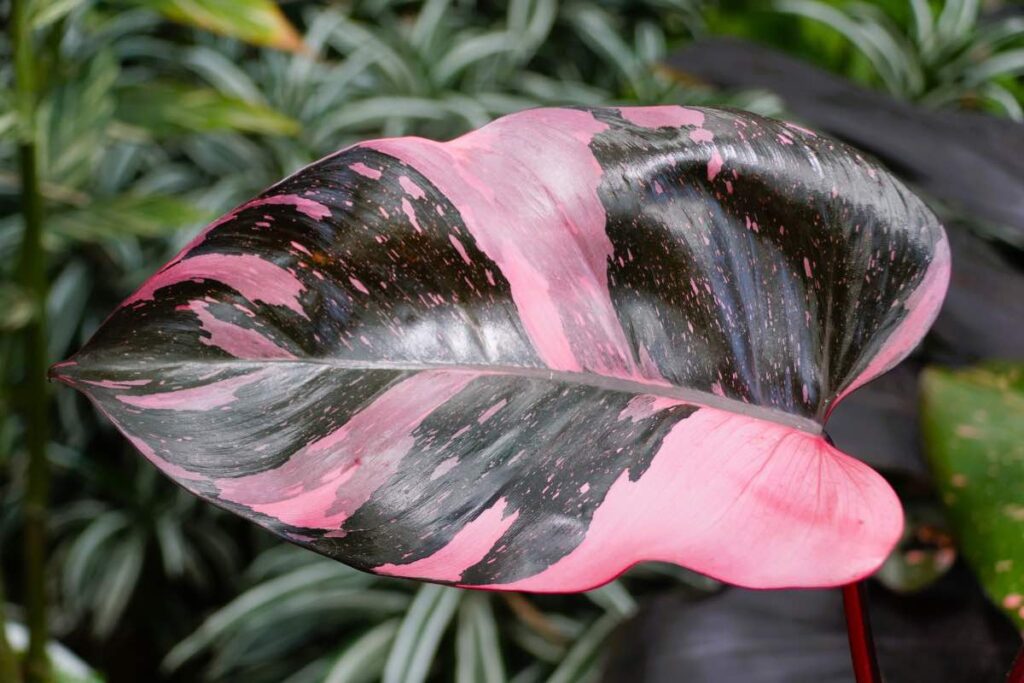
Who doesn’t love drama? and The Pink Princess Philodendron is a hot pink houseplant that is creating a sensation in every gardener’s wishlist just because of that. They are characterized by heart-shaped, deep green leaves with pink variegation. Social media, especially Instagram made it famous and demanding in the market for its striking beauty.
It is important to note that although it can be mistaken for the Philodendron pink congo, the variegation in the pink princess is natural. While, the pink congo’s variegation is achieved through chemical injection into the leaves, and they usually go back to green after a couple of months. To preserve the striking pink variegation of your pink princess philodendron, understanding proper care is important. But maintaining along with the cultivation process of these pink houseplants is easy.
| Maintenance | Easy |
| Water | Only when the top part of the soil is dry. Don’t let the soil completely dry or the soil get waterlogged. keep it evenly moist. |
| Humidity | Typical household humidity. |
| Light | Several hours of indirect or filtered light. |
| Fertilizer | Balanced liquid fertilizer during spring and summer. Refrain from feeding during the doormat season. |
| Toxicity | Its sap is toxic. |
| Mature growth | Three to four feet. |
Air purifying Pink Houseplants
9. Syngonium

Want a plant to purify your house while flaunting its beauty? Syngonium Pink Splash, also known as Pink Syngonium, has gained huge popularity among plant owners for the same reason. With its foliage showing a delicate baby pink color and arrow-shaped leaves, it’s gaining everyone’s attention. It purifies the air and releases oxygen at night, making it the perfect fit for bedroom decors.
What makes it even more appealing is its incredibly easy care requirements, making it a favorite choice among plant lovers worldwide. It can be cultivated as low maintenance indoor plant as well as an outdoor plant. The plant has gained across-the-board praise, with its presence dominating Instagram feeds. When it’s fully grown it looks bushy and fluffy, making it a great addition for terrarium setups.
| Maintenance | Easy |
| Water | Water when the soil is almost about to dry out. |
| Humidity | 40-50% humidity. |
| Light | Splash of sunny daylight does wonders to keep its pinkish charms. |
| Fertilizer | General houseplant fertilizer during spring and summer. |
| Toxicity | Toxic. |
| Mature growth | three to six feet |
10. Pink Aglaonemas
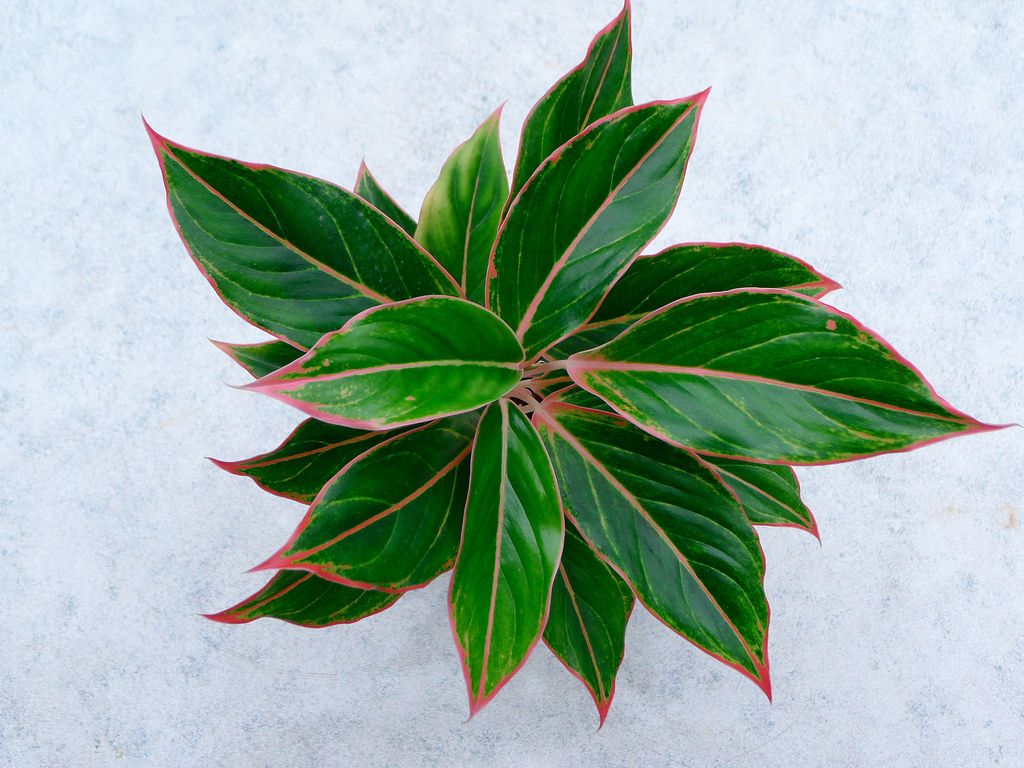
Pink Aglaonemas are known for their vibrant and colorful appearance. Its leaves have striking patterns of green and pink colors. Aglaonemas have an easy-to-maintain persona, that’s why you can place them in your office, bedroom, living room, or any dark corner of your house. These plants are known to clean formaldehyde and benzene from the air and work as air purifiers.
| Maintenance | is Very easy. |
| Water | when half of the soil surface is dry. |
| Humidity | High humidity |
| Light | Indirect light, but they can tolerate shades. |
| Fertilizer | All-purpose fertilizer. |
| Toxicity | Mildly toxic to pets and humans. |
| Mature growth | Up to three feet. |
Trailing Pink Houseplants for Hanging Baskets
11. The String of Hearts
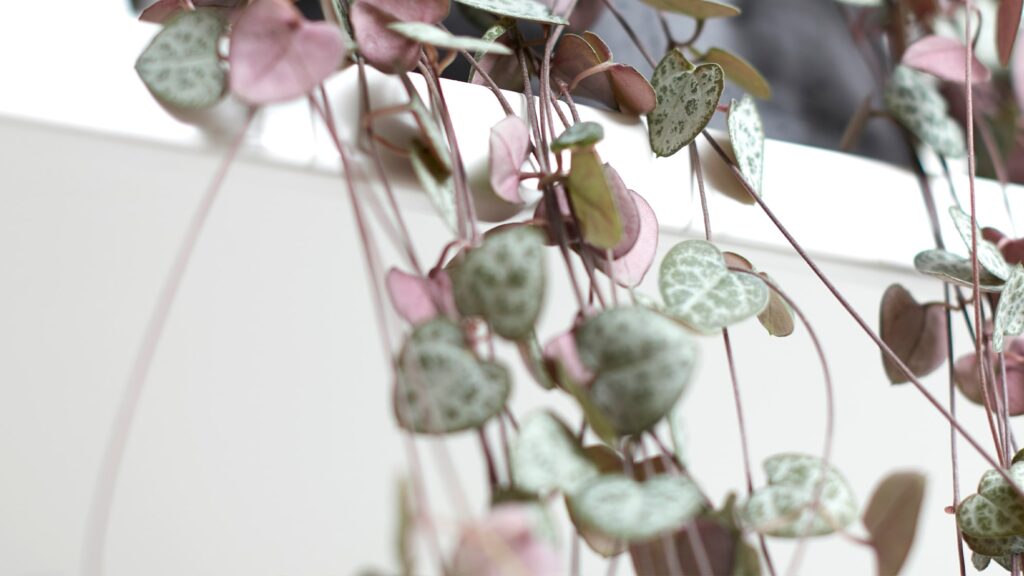
The String of Hearts plant is a beautiful and unique evergreen(but pink) houseplant. It’s a succulent, popularly used for its trailing nature, as a hanging basket houseplant. Elevate the look of boring walls or selves as hanging basket pink houseplant.
Originating from South Africa, Swaziland, and Zimbabwe, the String of Hearts’ leaves, shaped like hearts, as the name cleared it out. The leaves have a dark green base with variegated silver markings, with cream, pink, and green patterns. With a long lifespan and fast growth, its vines can grow up to twelve feet in length when it’s fully mature. During winter, it also enters a dormant phase, slowing down its growth. To fully appreciate its breathtaking cascade, it is best to hang this plant in a high spot, where it can gracefully spill out of its pot like a free waterfall.
| Maintenance | Medium |
| Water | Evenly moist, once a week, when the top two inches of the soil surface is dry. |
| Humidity | Can tolerate dry weather, but 40%-50% humidity is ideal. |
| Light | Bright light but not direct sunlight. |
| Fertilizer | Infrequent, half-diluted fertilizer from may-august, once a month. |
| Toxicity | Non-toxic. |
| Mature Growth | twelve feet. |
12. Pink lady

The Callisia Repens Pink Lady, also known as the Creeping Inch plant, Callisia Pink Panther, or Turtle Vine, is a stunning pink houseplant that will add beauty to any room. They have a trailing tendency as they grow long, they spill from the edge of the pot, and that makes it the perfect fit as a beautiful fluffy bush hanging basket plant.
The pink lady is a perennial succulent with a slow growth habit, generally growing in late spring and early summer. This pink beauty can reach a height of up to 4 inches and spread over 4 feet or more. Its thin stems hold small, round leaves with a waxy texture, showing a variety of colors ranging from green stripes to delicate shades of pink and cream all over the leaves. Pink Ladies are easygoing plants that enjoy moist soil and prefer indirect sunlight. They demand minimal maintenance to flaunt and add a touch of elegance to any space.
| Maintenance | Easy |
| Water | water it and keep the soil evenly moist, not soggy or bone dry. |
| Humidity | Household humidity |
| Light | Six hours of filtered sunlight near the east-facing window. |
| Fertilizer | Liquide plant fertilizer during spring and summer, don’t fertilize during slow growth seasons. |
| Toxicity | pet and human-friendly. |
| Mature growth | is four to five inches. |
Pink Houseplants with dramatic leaf shapes
13. Coleus

With its incredibly vibrant foliage in a flashy array of colors, coleus screams extraordinary. It’s known by other fun names as well like painted nettle, and poor man’s Croton. Their leaves are full of colored combinations with bold patterns, pink, green maroon, red, and any color you can think of. They even come in various leaf sizes and shapes, giving you the opportunity to find the perfect fit for any area.
The coleus plant is very easy to maintain and propagate. You can propagate them just by stem cutting method in water. Growing a new plant from seeds takes around ten to twelve weeks. They prefer fertile, well-draining soil and thrive in areas with partial shade, although many varieties can tolerate full sun. It’s important to note that coleus plants grow really quickly, so you can plant them close together for dense and spectacular growth. These versatile plants are a great choice for adding a pop of color to your garden or brightening up those dull corners, both indoors and outdoors.
| Maintenance | Easy and beginner friendly. |
| Water | Let the soil dry out mildly before every watering session, you can use a mulch to keep the moisture. |
| Humidity | They like high humidity. Keep them away from AC rooms. You can put them in the bathroom or mist them regularly during dry weather. |
| Light | Medium to partial sunlight. |
| Fertilizer | Use fertilizers that are rich in nitrogen, once a month, in the growing season. |
| Toxicity | Mildly toxic for pets. |
| Mature growth | Three feet. It can vary according to different species. |
14. Pink moonstone
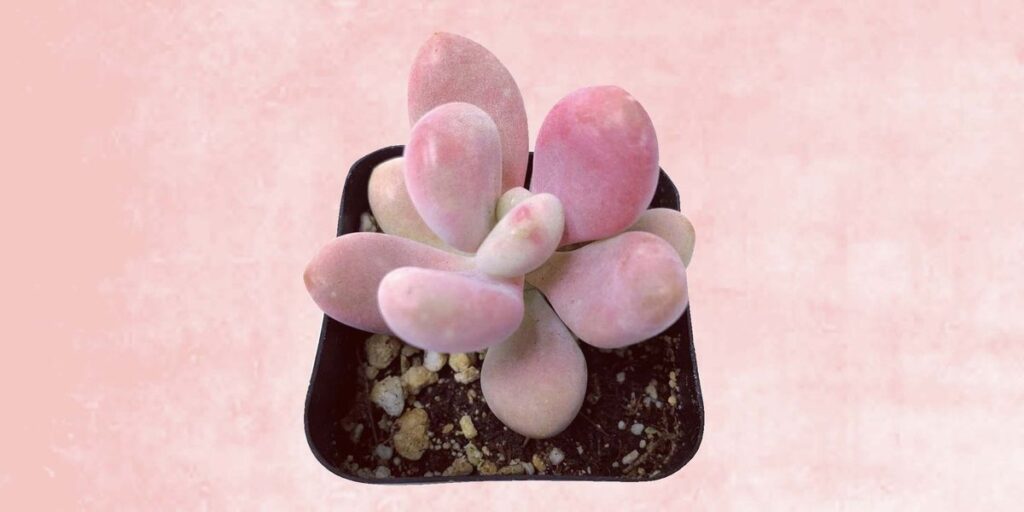
If you are someone who loves to collect unique-looking plants, you shouldn’t think twice before getting a pink moonstone for yourself. As the name suggests, these pink houseplants’ foliage looks like tiny pink stones. They will provide a unique aesthetic with their chubby leaves and silvery pink color no matter where you showcase them.
Native to Mexico, pink moonstone plants also go by the name Pachyphytum Oviferum. Like its other succulent friends, they are easy to take care of and they are equipped to tolerate any kind of circumstances as an indoor or outdoor houseplant. These plants don’t grow more than four inches and will fit like gloves in your compact areas. With their ideal condition, they can produce flowers during early spring. The flower petals are usually green and white in color on the edges and can vary from beige to deep pink.
| Maintenance | Very easy and beginner friendly. |
| Water | They store water in their chubby leaves and require minimal water. As winter is their growing season, they require more water in winter. |
| Humidity | Regular indoor humidity, the ideal being 40%. They are dry air resistant. |
| Light | Partial and indirect light. |
| Fertilizer | Any organic fertilizer before spring. |
| Toxicity | Not toxic. |
| Mature growth | is four inches high and twelve inches wide. |
Fragrant Pink Houseplants
15. Hoya

The Hoya plant is a pink flowering plant, also known as a wax plant, characterized by its thick, glossy leaves that trail down from the pot-like vines. They produce ball-like clusters of sweetly scented flowers similar to milkweed plants. The flowers are waxy and commonly found in shades of pink or white. They are from Australia and Asia’s tropical regions and are known for their longevity.
You can train a hoya plant to grow as a vine, or let it drape over the edges of its container. In either case, the plant can reach a length or height of 2 to 4 feet. Hoyas thrive in bright, indirect sunlight and should receive around six hours of it each day. It’s essential to provide them with moderately moist soil that is well-draining and allows the top layer surface to dry out between watering sessions. They appreciate a humid environment, so regular misting or maintaining humidity levels is beneficial. To keep your hoya healthy, you should fertilize it with a well-balanced fertilizer on a monthly basis.
| Maintenance | Easy to medium. |
| Water | Weekly. Let the soil dry out completely between every watery watering session. |
| Humidity | High humidity |
| Light | Two to six hours of filtered sunlight. |
| Fertilizer | Balanced nitrogen, phosphorus, and potassium fertilizer once a month. |
| Toxicity | Non-toxic |
| Mature growth | Two to four feet. |
Pink Houseplants for Feng Shui benefits
16. Orchid
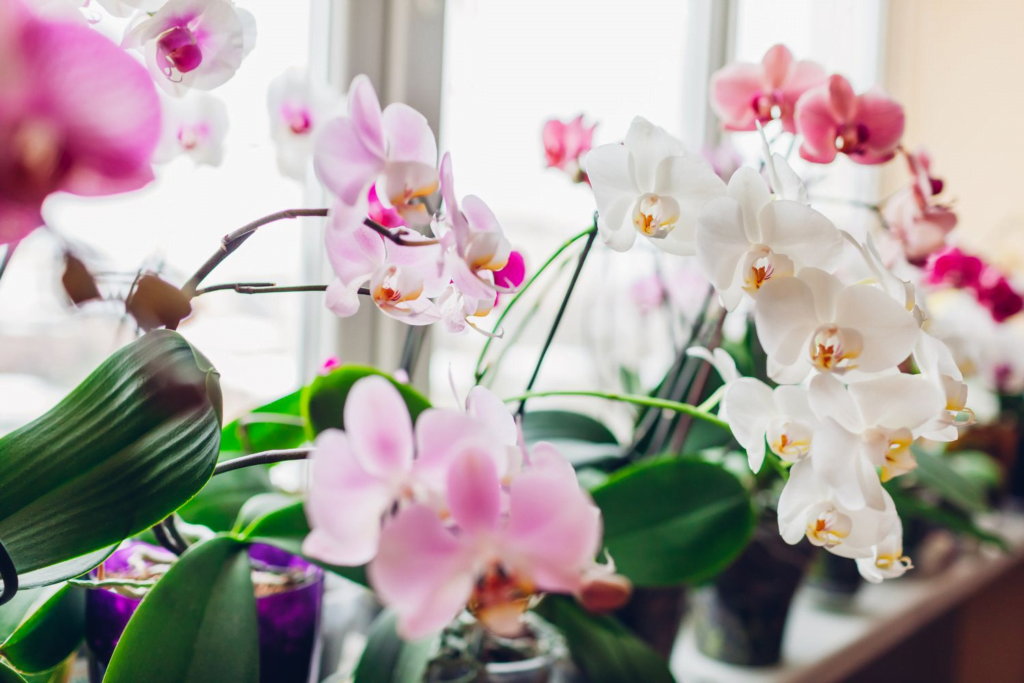
Orchids (Orchidaceae) are widely grown as houseplants and can be easily cared for once you know their specific needs and maintenance requirements. A variety of orchid species are available in the market, some common among them are Dendrobium, Cattleya, and Phalaenopsis, and most of them are feng shui approved to bring good luck. Pink orchid is believed to bring self-care and love.
These orchids share similar physical features such as tall and curved stems called flower spikes, large waxy leaves that help retain moisture, and vibrant, unique flowers. When it comes to caring for orchids indoors, the golden rule is to replicate their natural conditions as closely as possible. This means providing the atmosphere of the way orchids grow in the wild, with their roots clinging to rough bark.
| Maintenance | Medium to hard. |
| Water | Room temperature water, twice a week in the warmer season and once a week in winter. |
| Humidity | 40%-70% |
| Light | Bright but not too harsh light essential for blooming. |
| Fertilizer | Orchid-specific fertilizer during the growing season. |
| Toxicity | Non-toxic. |
| Mature growth | one to three feet. |
17. Begonias
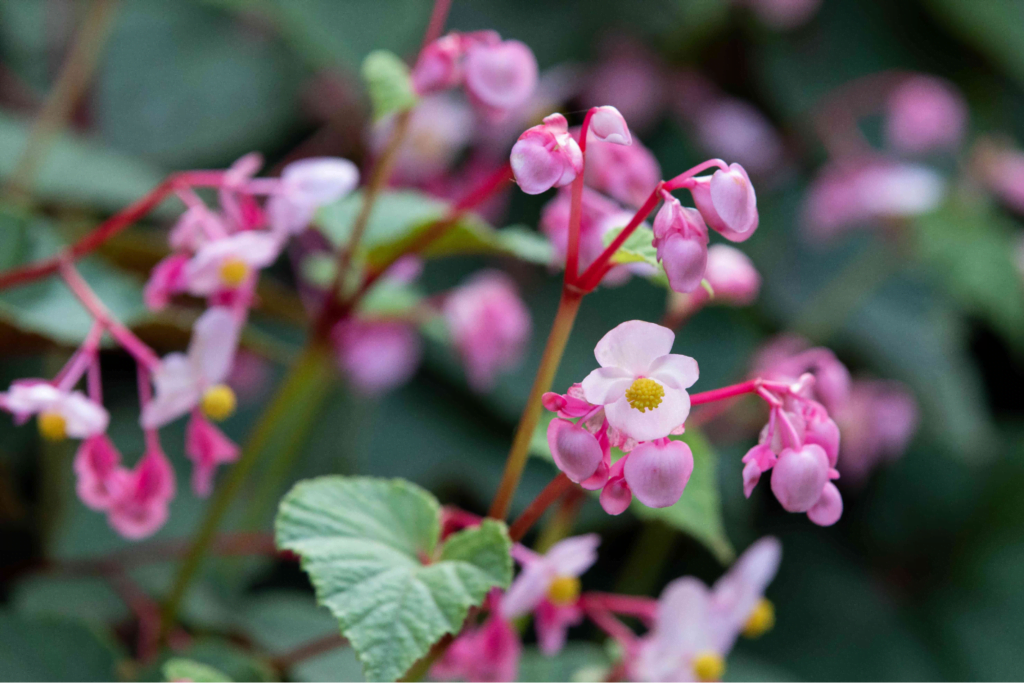
Begonias come in various colors, but they are mostly recognized for their bright pink flowers. These easy-to-care flowers can adapt to different conditions, making them popular among gardeners who want to elevate their front yards or indoor looks and create a cheerful atmosphere.
China is known for having one of the highest numbers of begonia flower species growing in their wild. The southern regions of China have a suitable climate and soil for these beautiful flowers to grow. Begonia plants are commonly believed to bring happiness and fortune to one’s home. According to Feng Shui principles, these plants are said to attract good luck in various aspects of life, such as love, career, and personal relationships. It is believed that having begonias in your living space can positively influence these areas and create a harmonious environment.
| Maintenance | Beginner-friendly, easy care. |
| Water | Let the soil dry out a bit before each watering session. |
| Humidity | Low humidity. |
| Light | Partial shade. |
| Fertilizer | Fertilizers with high phosphorus levels for blooms. |
| Toxicity | Not pet and human-friendly. |
| Mature growth | is six to eight inches. |
Pet-Friendly pink houseplants
18. Pink prayer plant

The Maranta genus which we commonly know as the pink prayer plant, is the name dedicated after Bartolomeo Maranta, an Italian physician and botanist from the 16th century. These pink houseplants are consists of several small, low-growing plants and are native to Brazil. This plant earned its common name because its leaves stay flat during the day and then fold up, just like hands in a prayer position, during the night.
The pink prayer plant is a tropical plant known for its ornamental value. The first thing that catches attention is the leaves that have the contrast of three colors green, pink, and yellow. Green is the base, yellow is the midrib, and pink is the veins. As a slow-growing plant, the prayer plant can reach a height of up to one foot when grown indoors. It is quite popular as a houseplant and can be cultivated and cared for indoors throughout the year.
| Maintenance | Easy |
| Water | Filtered water, once every 1-2 weeks. Let half of the soil surface dry before watering again. |
| Humidity | Normal household humidity. |
| Light | Medium indirect light. |
| Fertilizer | Water-soluble houseplant fertilizer. |
| Toxicity | Non-toxic. |
| Mature growth | Six to twelve inches. |
Pink Houseplants with Aesthetic Color contrast
19. Anthurium pink tickled

Tickled Pink is a cut flowering plant that has green leaves and a single-petal pink flower with a subtle yellow center. Pink, yellow, and green combination create a beautiful color contrast in a single plant. Anthurium also does not have a dormant season, which makes it ideal for bedroom decor pink houseplant.
NASA has recognized Anthurium as an air-purifying plant, capable of absorbing harmful impurities. This quality makes it a perfect indoor plant for both home and office spaces. Anthurium is generally considered easy to cultivate and propagate. With the right conditions, Anthurium plants can produce long-lasting blossoms throughout the whole year. Recently you can get many types of Anthurium, offering a variety of flower sizes, shapes, and colors for you to choose from.
| Maintenance | Easy |
| Water | Keep the soil moist. Do not let it dry out completely. |
| Humidity | High humidity. |
| Light | Bright and indirect light for pigment and bloom. |
| Fertilizer | Half-strength houseplant fertilizer. |
| Toxicity | Toxic to humans and pets. |
| Mature growth | Fourteen to eighteen inches. |
Edible Pink Houseplants
20. Geraniums
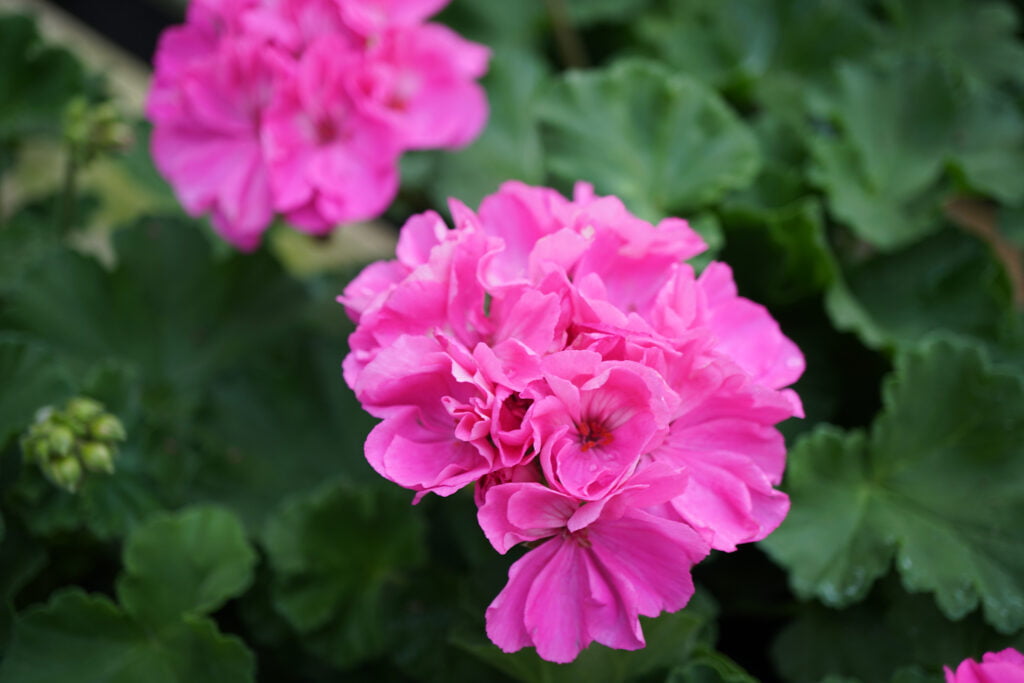
Scented geraniums have pink foliage and flowers with a delicious floral scent, which can be used to create unique edible flower desserts. While the leaves are not usually consumed whole, they can be used as a culinary herb or infused into dishes. These plants not only add beauty to your garden but also make for attractive edible pink houseplants when grown indoors.
Scented geranium plants, despite their name, are not actually true geraniums. They belong to the Pelargonium genus and are classified as tender perennials. In the United States and Europe, they are cultivated annual plants. However, their beauty is admired worldwide. The great thing regarding scented geraniums is that they need very minimal care, making them a favorite among gardeners and food lovers.
| Maintenance | Easy |
| Water | Soil surface should be dry enough to apply water again. |
| Humidity | Well resistant to dry air |
| Light | Partial shade to full sun. |
| Fertilizer | Half-strength houseplant fertilizer. |
| Toxicity | Toxic to pets. |
| Mature growth | one to three feet. |
Benefits of Pink Houseplants:
Symbol of Love:
According to feng shui, the color pink symbolizes the spirit of love. Love can come in any form platonic love, self-love, or a deep connection with another person. A pink houseplant can make a great housewarming gift, especially for those starting a new family.
Shade lover:
With the vast range of pink houseplants species available, you will definitely have options to choose from for your shady areas. If your window cube is already occupied with your greens, you can place your pink plant near them in a less sunny spot, they won’t mind!
For many plant species, the bathroom is a place for insufficient sunlight. But plants like, spiderwort will thrive in highly humid and less light bathroom weather.
Ornamental value:
Just place your pink houseplant in between your greens and it will become a centerpiece.
Conclusion
I hope that we gave you plenty of alternatives to pick from. We pointed out the specialty of each pink houseplant we talked about like some are shade loving, some are safe for pets, and some even work as an air purifier or perfume, so that it will be easier for you to decide on your first pink plant. Happy gardening!
FAQs
Q1. Are pink houseplants difficult to care for?
Most pink houseplants are fairly easy to maintain. But most of them originated from the tropical environment, so they need high humidity. You have to mist them frequently during dry seasons. The pink pigment gets darker with sun exposure, so to achieve that you have to provide sunlight. Other than that occasional fertilizer application and well-draining soil is all most of them require.
Q2. Can I grow pink houseplants in low-light environments?
Due to the higher amount of pink color and less green chlorophyll content in each leaf, pink houseplants generally require little more light than usual to develop an equal amount of glucose through photosynthesis.
Anyway, this adjustment in light requirements rarely poses any challenges, especially since many of these plants naturally thrive in shaded areas beneath thick tree canopies. As a result, adapting to the increased light needs of pink houseplants remains manageable and normally does not cause any notable problems.
However, to avoid any kind of inconvenience due to light you can choose the plant we mentioned above for the shady corner of your house.
Q3. Which pink houseplants are suitable for beginners?
Fittonia, cordyline, aglaonema, tradescantia nanouk, earth star, and polka dot plant are some of those pink plants that are suitable for beginners for their easygoing personality.
Q4. Do pink houseplants require any special fertilizer?
Ninety percent of pink houseplants only require half-strength houseplant fertilizer, once a month, during growing seasons. Some plant does require special attention for optimal growth. For instance; coleus requires nitrogen-enriched fertilizer, and Christmas cactus needs to be diluted potassium-enriched fertilizer, nerve plants need to be fed every two to four weeks.
Q5. Are there any pink houseplants that flower year-round?
Kalanchoe is an all-season blooming plant. The vibrant pink blossoms that rise from the succulent leaves create a gorgeous decoration of color within any room. With just a little maintenance, this plant will well reward you with blossoming all year round, providing a constant exhibition of its incredible beauty.
Related Articles
- 15 Best Plants for Front Door Entrance India | Auspicious plants for front door
- 10+ Money plant Benefits That Will Make you Keep It In Your House
- Are Spider Plants Toxic to Cats?- 4 Ways To Prevent Your Cats From Eating Spider Plants.
- Best Plants for the House – 8 Top Apartment Plants That You Can’t Miss
- How to Braid Your Snake Plant: Tips and Care Guide
- 20+ Rare and Unusual Peace Lily Varieties You’ll Love





